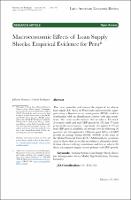Macroeconomic effects of loan supply shocks: empirical evidence for Peru

Fecha de publicación
2021-07-09Author
Martínez, Jefferson
Rodríguez, Gabriel
Formato
application/PDF
URL del recurso
http://hdl.handle.net/11651/4765Idioma
eng
Acceso
Acceso abierto
Compartir
Metadata
Show full item recordAbstract
This paper quantifies and assesses the impact of an adverse loan supply (LS) shock on Peru’s main macroeconomic aggregates using a Bayesian vector autoregressive (BVAR) model in combination with an identification scheme with sign restrictions. The main results indicate that an adverse LS shock: (i) reduces credit and real GDP growth by 372 and 75 basis points in the impact period, respectively; (ii) explains 11.2% of real GDP growth variability on average over the following 20 quarters; and (iii) explained a 180-basis point fall in real GDP growth on average during 2009Q1-2010Q1 in the wake of the Global Financial Crisis (GFC). Additionally, the sensitivity analysis shows that the results are robust to alternative identification schemes with sign restrictions; and that an adverse LS shock has a greater impact on non-primary real GDP growth.
Editorial
Centro de Investigación y Docencia Económicas
Derechos
La revista Latin American Economic Review autoriza a poner en acceso abierto de conformidad con las licencias CREATIVE COMMONS, aprobadas por el Consejo Académico Administrativo del CIDE, las cuales establecen los parámetros de difusión de las obras con fines no comerciales. Lo anterior sin perjuicio de los derechos morales que corresponden a los autores.
Tipo
Artículo

